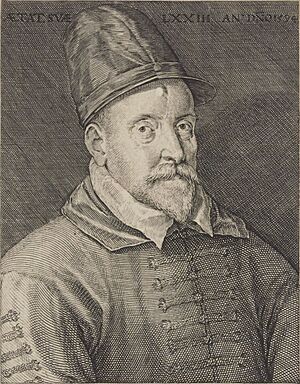Philippe de Monte facts for kids
Philippe de Monte (born 1521 – died 1603) was a famous composer from Flanders (which is now part of Belgium). He lived during the late Renaissance period. He wrote many madrigals, which are a type of song for several voices, usually without instruments. In fact, he wrote more madrigals than almost anyone else at that time! People said he was one of the best composers in Europe.
Life
Philippe de Monte was born in Mechelen. As a boy, he sang in the choir at St. Rumbolds Cathedral. Later, he moved to Italy, which was common for young composers from Flanders. In Italy, he became well-known as a composer, singer, and teacher.
He worked in Naples and Rome. For a short time, from 1554 to 1555, he was in England. He worked for Queen Mary I, who was married to King Philip II of Spain. Monte said he did not like working in Philip's choir because all the other singers were Spanish.
In 1568, Monte became the Kapellmeister (music director) for Maximilian II. Most of his music was printed in Venice, Italy. He wanted to use Italian publishers to stay close to where madrigals were popular. He was very good at finding new musicians for the royal chapel. Even Lassus, another famous composer, noticed how good the music was in Vienna after Monte took over.
For ten years, Monte was also an active teacher at the Imperial Court. He worked for the rest of his life in the Habsburg courts, first in Vienna and then in Prague from 1583. Philippe de Monte died in Prague in 1603.
Music and Influence
Monte was a very busy composer. He wrote both sacred (religious) and secular (non-religious) music. Most of his music was printed in German. He wrote about 40 masses and around 260 other sacred pieces. These included motets and madrigali spirituali, which were like madrigals but with religious words.
He published over 1100 secular madrigals in 34 books. His first music was published in 1554 when he was 33. From then on, many of his publications included his own prefaces. In these, he thanked the people who supported him financially.
Monte's madrigals were seen as some of the best compositions for five voices. His early madrigals were very modern. They often used chromaticism (notes outside the main scale) to show the meaning of the words. Later in his life, his music became simpler. It used short musical ideas and often had homophonic textures, where all voices move together.
Some of his favorite poets were Petrarch, Bembo, and Sannazaro. Unlike some composers who started simple and became more experimental, Monte did the opposite. He started with experiments and then moved towards unity and simplicity in his later works.
Philippe de Monte was famous across Europe. His music was printed, reprinted, and shared widely. He was described as a "quiet, unassuming man." He had many students, including Gian Vincenzo Pinelli. This helped pass on his musical skills to the next generation, who developed the early Baroque style. Philippe de Monte's madrigals are still performed today.
Recordings
- Alexander Utendal & Philippus de Monte, Motets, Capilla Flamenca and Oltremontano, 2002 (Passacaille 937).
- Philippe de Monte: Missa Ultimi miei sospiri, and other sacred music, Cinquecento, 2008 (Hyperion CDA 67658).
- Praga magna incl. Missa super Confitebor tibi Domine and motet Langue a´ll vostro languir by Philippe de Monte, Cappella Mariana, Vojtěch Semerád 2014 (Artevisio0.


